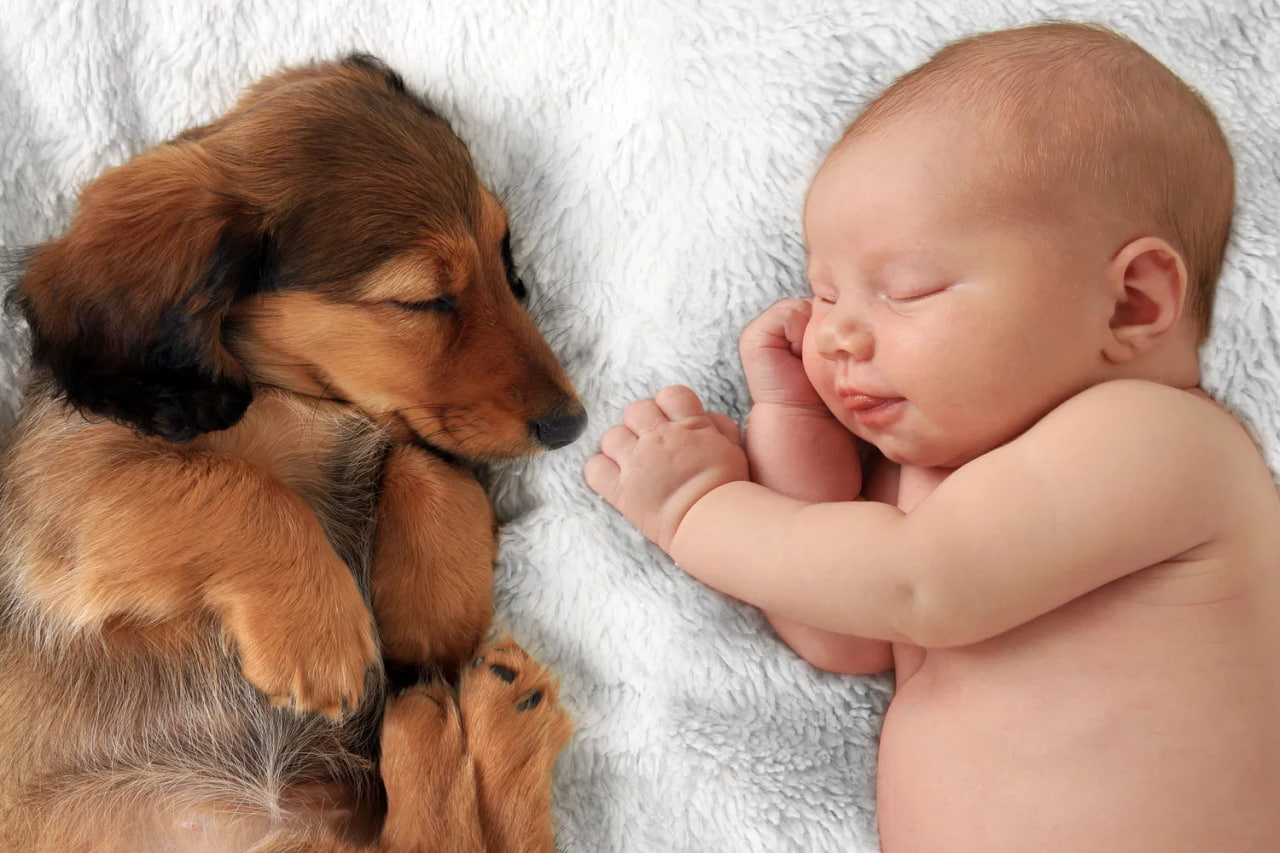In today’s bustling households, selecting a dog that harmonizes with family life, especially with children, is paramount. Dachshunds, known for their distinctive appearance and lively personalities, are a popular choice. This guide explores whether are dachshunds good with kids, highlighting their attributes, potential challenges, and essential considerations.
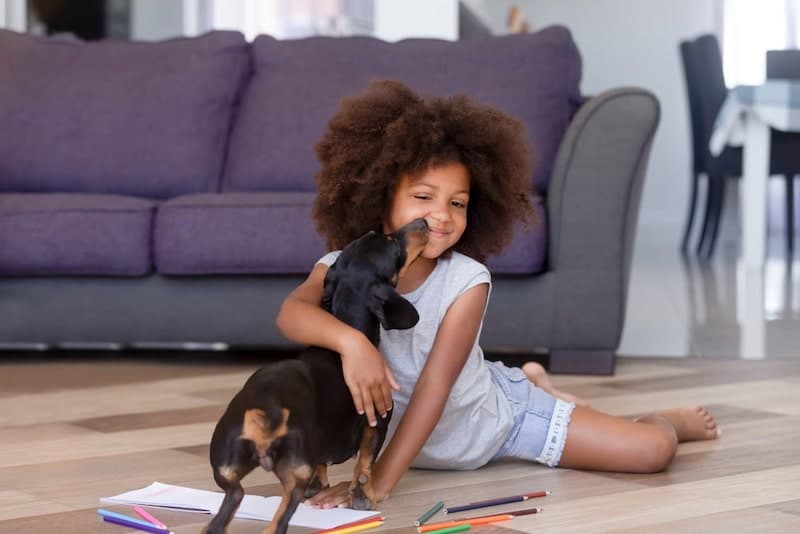
Are Dachshunds Good with Kids? Reasons To Choose This Breed as Your Family Pet
Playful and Energetic Nature
Dachshunds possess a playful spirit that resonates with children, making them engaging playmates.
Loyalty and Affection Towards Family Members
Known for their loyalty, dachshunds often form strong bonds with their human family members, including children.
Watch Over Children
They Guard Children Dachshunds frequently behave like guard dogs and can be extremely protective of their human companions. They are constantly vigilant for possible hazards and risks to their loved ones. This characteristic may lead them to bark at individuals who come near your residence or at unfamiliar people they might meet during walks. Dachshunds enjoy being part of a group and will adopt your family as their new pack. Their role then involves safeguarding all pack members.
Love to Play
They Enjoy Playing Dachshunds can be quite lively and playful. Indeed, receiving adequate exercise daily is crucial for their overall health and happiness. When this breed engages in sufficient physical activity, it can prevent them from getting into mischief and maintain a healthy weight. Educating your child on how to interact safely with your dog can aid in providing this necessary exercise. This can also strengthen the bond between your child and dog. Additionally, you could establish a daily family walk to allow everyone to benefit from essential exercise together.
They are Adventurous
Finally, dachshunds can be very adventurous. They love getting out and exploring new places with their families. This makes them an excellent pet to bring along for family vacations, such as camping, hiking, or even swimming.
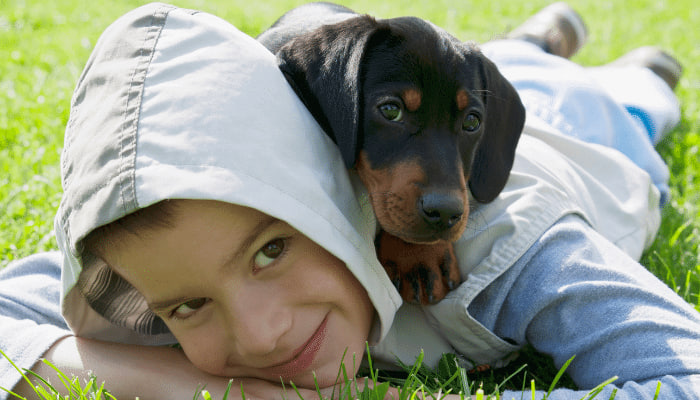
Potential Dachshund Challenges with Children
Sensitive to Rough Handling
Dachshunds have a small size and long body, which makes them particularly vulnerable to rough handling. Children, especially younger ones, may unintentionally handle them roughly due to their natural curiosity and playfulness. This can cause stress and discomfort for the Dachshund, potentially leading to fear or defensive behavior. It’s crucial to teach children to interact gently and respectfully with Dachshunds to avoid causing them distress.
Stubbornness and Difficulty in Training
Through dachshund history, this breed is known for their independent and sometimes stubborn nature. This can make training a challenge, especially for novice owners or families with young children who may not consistently enforce rules and commands. Dachshunds may test boundaries and resist commands, requiring patience, positive reinforcement, and consistent training methods. For families with children, it’s essential to involve them in training sessions under adult supervision to ensure they understand how to interact appropriately with the dog and reinforce desired behaviors.
Back Problems and Risk of Injury
Dachshunds are prone to a condition called Intervertebral Disc Disease (IVDD) due to their unique physique with a long spine and short legs. IVDD can cause painful back problems and even paralysis if the discs become herniated or ruptured. Activities that strain the back, such as jumping on and off furniture or being handled roughly, can increase the risk of injury. Children may inadvertently engage in activities that put stress on the Dachshund’s back, so it’s crucial to educate them on the importance of gentle handling and to supervise interactions to prevent accidents.
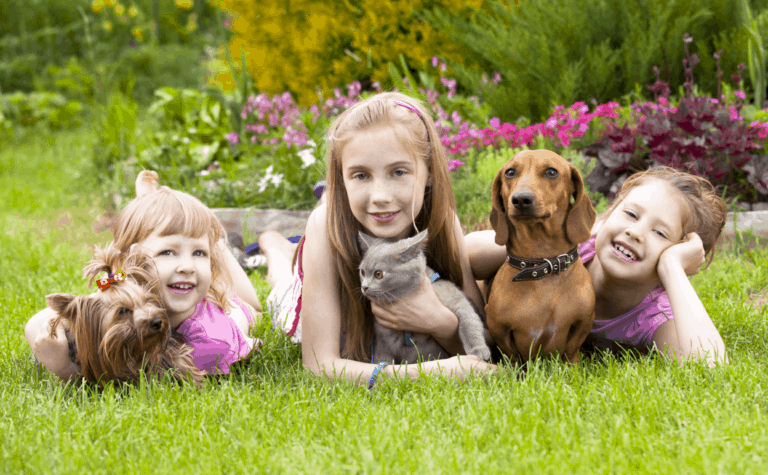
Consider Age
Dachshunds with Babies and Toddlers:
Extra Caution Needed: Dachshunds are fragile dogs, and their long body makes them particularly vulnerable to accidental injury from rough handling or falls. Babies and toddlers may not fully understand how to interact gently with pets, which can lead to unintentional harm to the Dachshund. Therefore, it’s crucial for parents to supervise all interactions closely and teach young children how to treat the dog with care and respect. It’s advisable to create safe spaces where the Dachshund can retreat if they feel overwhelmed or need a break from interaction.
Dachshunds with School-Age Children:
Active Play and Companionship: School-age children (typically ages 6 to 12) can often develop strong bonds with Dachshunds. These children are usually more capable of understanding and following instructions for gentle handling and appropriate play. Dachshunds, despite their small size, enjoy active play sessions like fetch or short walks. This age group can engage in structured activities with the dog, which not only provides physical exercise for the Dachshund but also fosters a sense of companionship and responsibility in the child.
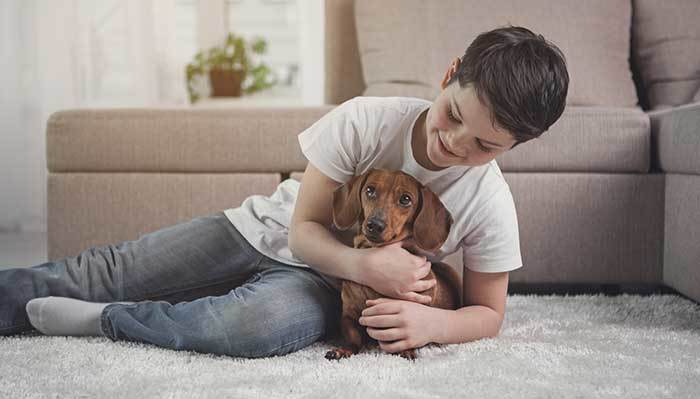
Dachshunds with Teenagers:
Rewarding Companionship: Teenagers (ages 13 and up) can form deep connections with Dachshunds, appreciating their loyalty and affectionate nature. Proper training and understanding are key in this stage, as teenagers can actively participate in the dog’s care, training, and exercise routines. Dachshunds can serve as valuable companions for teenagers, offering emotional support and companionship during this transitional phase of life. Moreover, caring for a pet can teach teenagers important life skills such as responsibility, empathy, and patience.
Training Dachshund Dogs to be Good with Children
Training Dachshunds to behave well around children is essential for fostering a safe and harmonious relationship between the dog and the young family members. Here are detailed steps and considerations for effectively training Dachshunds to be good with children:
1. Early Socialization:
- Exposure to Children: Introduce your Dachshund to children from a young age in controlled settings. This helps the dog become familiar with children’s movements, voices, and behaviors.
- Positive Experiences: Ensure that interactions with children are always positive. Reward calm and gentle behavior from both the Dachshund and the children with treats, praise, and playtime.
- Supervised Encounters: Always supervise interactions between your Dachshund and children, especially initially. This allows you to intervene if necessary and ensures that interactions are safe and positive for both parties.
2. Basic Obedience Training:
- Sit, Stay, and Come: Teach your Dachshund basic obedience commands such as sit, stay, and come. These commands are essential for managing interactions with children and controlling the dog’s behavior in various situations.
- Positive Reinforcement: Use positive reinforcement techniques such as treats, praise, and toys to motivate and reward your Dachshund for obeying commands. Consistency and patience are key to successful training.
3. Gentle Handling Training:
- Teach Gentle Interaction: Teach children and adults alike how to interact gently with the Dachshund. Show them the proper way to pet, approach, and play with the dog to avoid accidentally startling or hurting the dog.
- Body Handling: Get your Dachshund accustomed to being touched all over their body, including paws, ears, and tail. This helps prepare them for interactions where children might inadvertently touch them in different ways.
4. Creating a Safe Environment:
- Safe Spaces: Provide your Dachshund with safe spaces where they can retreat if they feel overwhelmed or need a break from interaction with children.
- Child-Free Zones: Establish areas in your home where the Dachshund can relax undisturbed by children, ensuring they have a quiet place to retreat to when needed.
5. Consistent Rules and Boundaries:
- Consistency: Establish consistent rules and boundaries for both the Dachshund and children. For example, teach children not to disturb the dog while it’s eating or sleeping and to respect the dog’s personal space.
- Family Involvement: Involve the entire family in training and setting boundaries. Consistency in expectations and responses to behavior helps reinforce positive interactions between the Dachshund and children.
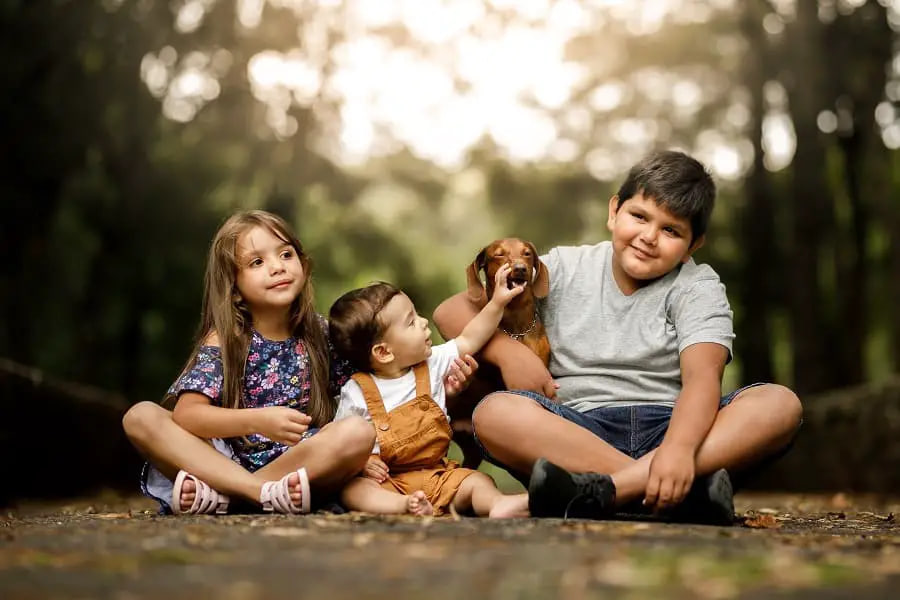
Consistent Rules and Boundaries
6. Monitoring and Adjustment:
- Monitor Interactions: Continuously monitor interactions between your Dachshund and children, especially as children grow and their behavior changes. Adjust training and supervision methods as needed to accommodate developmental stages and changes in behavior.
- Professional Help: If you encounter challenges in training your Dachshund to be good with children, consider seeking advice from a professional dog trainer or behaviorist who has experience with both Dachshunds and child-dog interactions.
By following these detailed steps and considerations, you can effectively train your Dachshund to behave appropriately around children, ensuring a positive and safe relationship between your pet and your family members. Consistency, patience, and positive reinforcement are key to fostering a harmonious environment where both children and Dachshunds can thrive together.
Decision Making
- Assess your family’s lifestyle and needs: Consider whether a dachshund’s temperament and care requirements align with your family’s lifestyle and dynamics.
- Adopt and buy a dachshund: Explore adoption or reputable breeders when acquiring a dachshund, prioritizing health and temperament.
- Prepare your home and family for a new dog: Ensure your home environment is safe and welcoming for a dachshund, integrating them smoothly into family life.
FAQs
Q : How Does the Shedding of Dachshund Dogs Affect Their Suitability as Pets for Families with Children?
A : Many people wonder ” do dachshund dogs shed “, the answer is: The shedding of Dachshund dogs can vary depending on whether they have smooth, long, or wire-haired coats. Generally, smooth-coated Dachshunds shed moderately, while long-haired and wire-haired varieties may shed more. Regular grooming and brushing can help manage shedding, making them suitable for families with children who may have allergies or prefer less fur around the house. It’s important to consider grooming needs alongside temperament when choosing a Dachshund for a household with kids.
Q : How do Dachshunds Typically Interact with Both Children and Cats in a Household, and What Factors Contribute to Their Compatibility with Both?
A : “Are dachshunds good with cats?” is the question of many people who are planning to adopt a dachshund. Dachshunds can vary in their interactions with both children and cats. Generally, their temperament and early socialization play significant roles. Some Dachshunds may get along well with both children and cats, while others may require careful introduction and supervision to ensure positive relationships are fostered. Understanding their individual personalities and behaviors can help determine compatibility in a multi-pet household.
Q : What are Some Signs that a Dachshund Might not be Comfortable Around Children, and How Should that be Addressed?
A : Signs that a Dachshund may be uncomfortable around children include growling, snapping, avoidance, stiff body language, ears back, or a tucked tail. Address this by positive exposure, reward-based training, supervision, teaching children to respect boundaries, and consulting a professional if needed.
Summary
In summary, the query “ are dachshunds good with kids? “ typically receives an affirmative response, thanks to their lively and devoted nature. Although individual disposition can differ, Dachshunds usually flourish in familial environments where they are given appropriate training and interaction. By cultivating a secure and caring atmosphere, Dachshunds can build robust connections with kids, demonstrating why these dogs are often considered child-friendly in numerous homes.
For more insights on Dachshunds and how great they can be as family pets, be sure to explore our homepage. You’ll find a wealth of informative articles and expert advice on pet care and ownership.

Cuddle Companions is your go-to resource for everything you need to keep your furry friends happy and healthy. We specialize in providing detailed and helpful information about the best foods, treats, and care practices for pets of all kinds. Whether you’re a seasoned pet owner or a new puppy parent, our team of experienced and passionate experts is dedicated to offering reliable advice and recommendations. At Cuddle Companions, we believe that a well-cared-for pet is a happy pet, and we’re here to help you every step of the way. Visit us at [bestdogfoodfordachshunds.net] for more information and resources.

